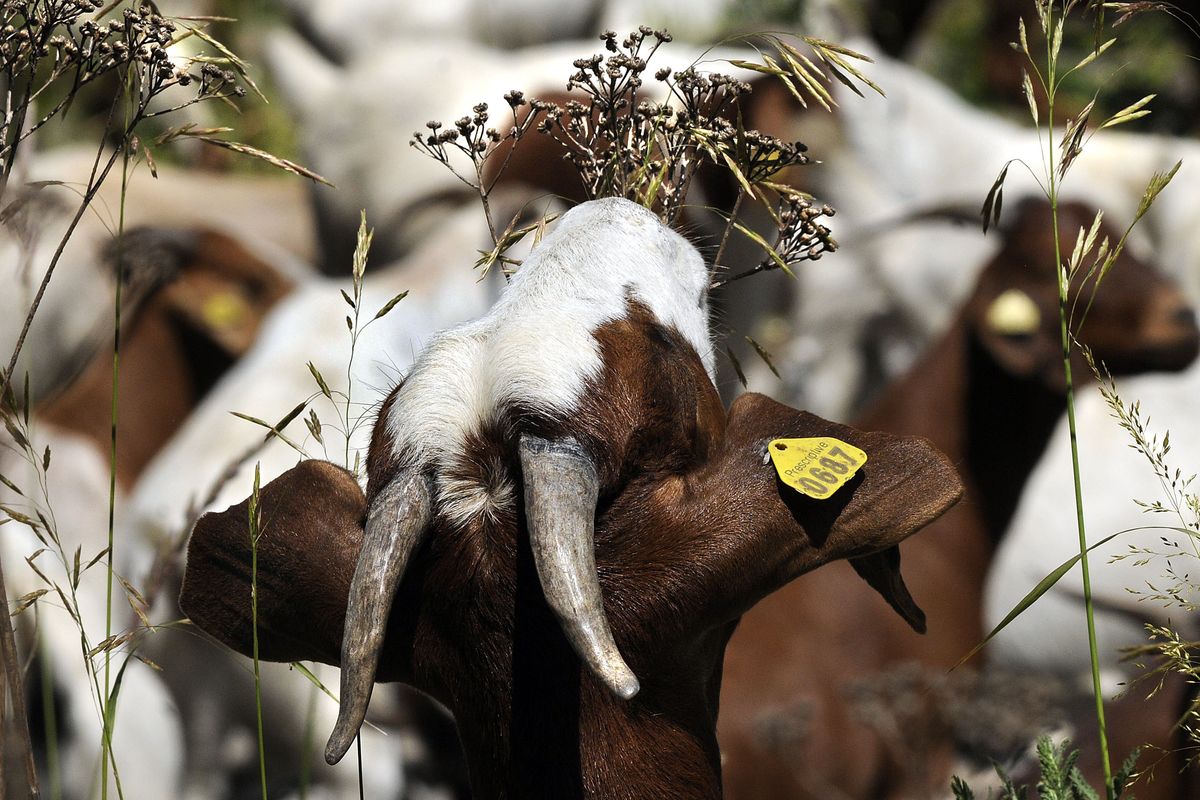Goats help park nip problem in the bud
Rented ruminants gorge on pesky knapweed, St. John’s wort, tansy
Heyburn State Park manager Ron Hise talks Tuesday about using goats to help battle noxious weeds in the park. (Kathy Plonka)
Heyburn State Park is renting 540 goats from a Grangeville, Idaho, rancher to help control weeds along Plummer Creek.
Each goat eats about 3 1/2 pounds of vegetation a day. Over the next week and a half, the herd will munch its way through dense thickets of invasive spotted knapweed, tansy and St. John’s wort along the stream, clearing the creek bottom for the return of native plants.
Aside from an occasional snort, the herd of Boer goats – a South African breed – grazed quietly Tuesday, intent on the bounty around them. The goats were yearlings, still growing and constantly hungry.
“Knapweed is a preferred food for them,” said Jeff Handel, the park’s natural resources manager. “So, it’s kind of like kids loose in a candy store.”
Grazing is the park’s latest weapon in the fight against invasive weeds. Knapweed, tansy and St. John’s wort were introduced from Europe decades ago. They’ve become pests in the American West, spreading aggressively and crowding out native plants that provide forage for wildlife.
Park officials also spray the weeds and release insects that prey on the seed heads. As a pilot program, the park is trying goats this year in the Plummer Creek corridor, where managers prefer not to use herbicides, Handel said.
Ray Holes, the owner of Prescriptive Livestock Services, is charging the park $1 per goat per day. Money for the project comes from $2 million federal stimulus grant for weed control in Benewah County.
Holes got into the goat rental business 10 years ago, after witnessing how successful goats were at controlling yellow star thistle on his ranch near White Bird, Idaho. Now, he has accounts from the Oregon Coast to central Montana.
A large liver and a legendary constitution give the goats an appetite for a wide variety of plants. St. John’s wort, for instance, can cause nerve damage or abortions in other livestock.
“They can process a lot of the toxins that make other animals sick,” Holes said.
But over the years, he’s learned to limit the herds’ intake of poison hemlock. After one memorable day of foraging on hemlock, the goats were lying around with bellyaches – as listless as cowboys who spent Saturday night drinking rotgut whiskey.
“They were acting like they had hangovers,” Holes said.
The goats develop a taste for different weeds, and this particular herd fancies knapweed. Part of the affinity comes from the foods their mothers ate when they were pregnant and nursing, Holes said.
On Tuesday, the goats were nibbling on knapweed, showing less interest in tansy. Two South American herders will drive the goats up and down the creek bottom over the next 10 days, until the herd grazes the weeds down to the ground.
Sometimes, several years of grazing are needed to get the weeds under control, Holes said. Other times, a single grazing will knock the weeds back enough so that they can be effectively sprayed the next year.
At Heyburn State Park, knapweed hasn’t flowered yet. The goats will nip off the buds before the seeds form, Holes said. If they can consume 70 to 80 percent of the plant, its root wad will start to shrink, he said.
Handel, the natural resources manager, would be thrilled if the telltale purple of blooming knapweed disappeared from the park’s meadows.
“We’d rather have native vegetation thriving in the park,” he said.

